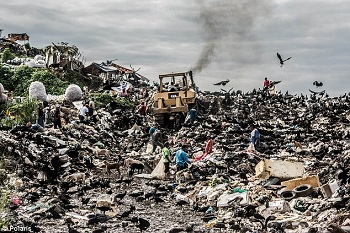Delhi is facing the threat of a major fire tragedy, which besides threatening lives could cause a significant rise in pollution levels. The risks of a major blaze were highlighted by the Deonar fire in Mumbai, which enveloped the city in thick smoke.
The presence of three landfill sites in Delhi – Bhalswa (in the northwest), Okhla (southeast) and Ghazipur (east) is primarily responsible for the danger. Rag pickers often set garbage ablaze in order to extract objects of interest to them and the fire typically spreads to other parts of the landfill site. Experts say that as the Okhla and Ghazipur garbage dumps are located in amidst densely populated parts of the city, they could be potential threats. All of them reached their retirement age around 2006 and should have been ‘capped and reclaimed’. The three MCDs (municipal corporations) have been hunting for new landfill sites but have so far failed to acquire enough.
They say that the existing sites are saturated and produce gases like methane from the decomposition of waste. Together, the three sites occupy close to 150 acres of land – twice the size of the Vatican City. They receive about 9,000 metric tonnes of garbage a day and the accumulated garbage makes a hill which stands at close to 25 metres – about the height of a 10-storey building, at each site. However, thanks to the lack of land, Delhi’s municipal corporations continue to use them. The landfills are perennially ablaze and also leach toxic juices into the ground. “There are small fires burning on the hill top always. It’s because filth is rotting inside in layers. During summers, when the temperature is especially high, methane gas is generated. When it comes in contact with air, fire erupts,” explained Shashi Bhushan Pandit, who works with rag pickers at these sites.
In a legal suit dated May 18, 2000 – Almitra Patel v/s Union of India – the Supreme Court had asked the Delhi Development Authority (DDA) to provide landfill sites to MCDs within four weeks. The east, north and south corporations had together demanded 1,500 acres of land. Since 2015, they have received a meager 23 acres in Dwarka, Rohini, Tikri Kalan, East Vinod Nagar and Shastri Park. Ravi Agarwal, Director, NGO Toxics Link, said: “Landfill must be absolutely the last option. Ideally, waste should be segregated at the source with appropriate processing at the nearest facility. In cities with population over 20 million, land obviously comes at a premium and landfills only vitiate the water and air.”








